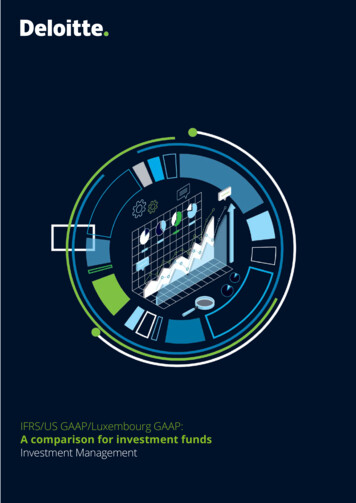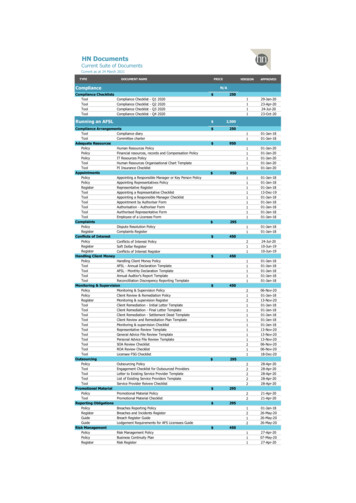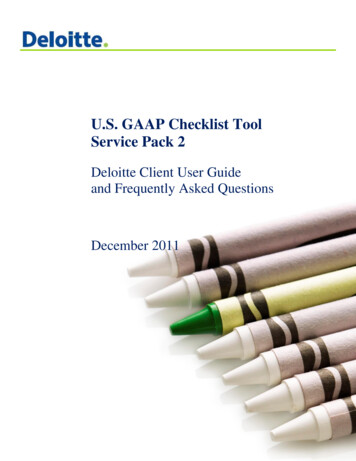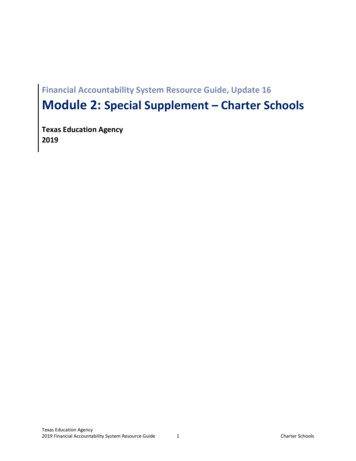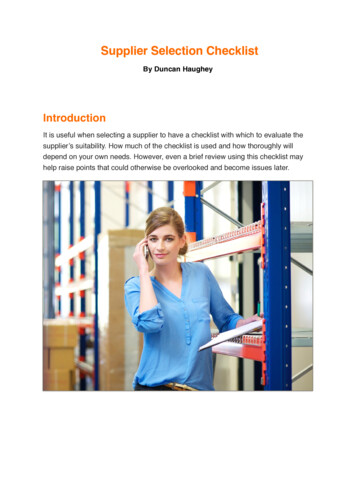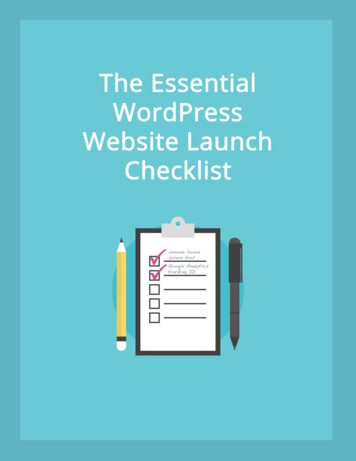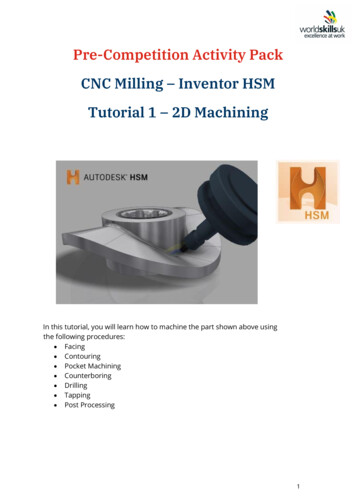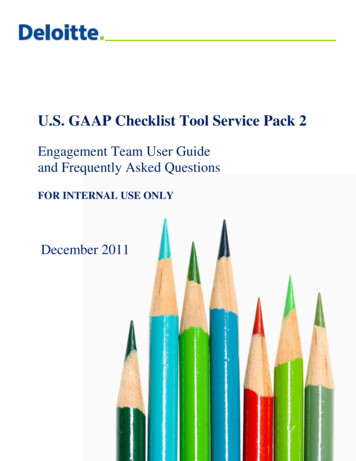
Transcription
U.S. GAAP Checklist Tool Service Pack 2Engagement Team User Guideand Frequently Asked QuestionsFOR INTERNAL USE ONLYDecember 2011
U.S. GAAP Checklist Tool — Engagement team user guide and FAQsOverview . 3What’s new in the U.S. GAAP checklist tool Service Pack 2 (October 2011 release) . 3Using this checklist tool as part of the audit . 4Checklist tool overview . 4Additional resources and information . 6Technical Library . 6Help and feedback. 6Accessing the U.S. GAAP checklist tool . 7Creating a new checklist . 7The scoping activity . 10Scoping overview. 10Excluding from scope . 11Review scoping . 12Print scoping . 12The response activity . 14How to respond to questions . 15Navigating to and answering questions . 15Viewing Codification guidance . 17Printing a checklist . 18Completing the checklist. 19Frequently Asked Questions . 20New Features in the October 2011 Service Pack 2 Release . 20Efficient and Effective Use of the U.S. GAAP Checklist Tool . 20Superseded Forms . 22Using a Checklist — Scoping, Responding, Printing, and Closing . 23Engagement Team and Client Interaction. 25Viewing the Codification within the U.S. GAAP Checklist Tool . 26–2–
OverviewOn July 1, 2009, the FASB Accounting Standards Codification (the “Codification) became the single source forall authoritative U.S. accounting guidance. All nongovernmental entities that report under U.S. GAAP arerequired to follow the guidance in the Codification for reporting periods ending after September 15, 2009.The Codification flattens the GAAP hierarchy into two categories: Authoritative (i.e., included in theCodification) and nonauthoritative (i.e., excluded from the Codification). The new U.S. GAAP checklist toolincludes all accounting and disclosure guidance from the Codification: Codification Accounting Guidance Sections: 25 — Recognition, 30 — Initial Measurement, 35 —Subsequent Measurement, and 40 — DerecognitionCodification Disclosure Guidance Sections: 45 — Other Presentation and 50 — DisclosureCodification Scope Guidance: Section 15 — ScopeSection 15 describes the types of entities and transactions to which the Subtopic under considerationapplies and is included to aid with the scoping activity only (i.e., there are no questions to answer in theresponse activity).Note: Other sections in the Codification (00 — Status, 05 — Background, 20 — Glossary, 55 — Implementation andIllustrations, 60 — Relationships, and 65 — Transition) are not included. Users of the U.S. GAAP checklist tool can referto these sections in Technical Library as necessary.What’s new in the U.S. GAAP checklist tool Service Pack 2 (October 2011 release)The following features are now available and apply not only to new checklists, but also completed and inprocess (i.e., created before the release of service pack 2) checklists: Scoping to the question level — Engagement teams and clients can exclude from scope at the questionlevel, those transactions, events, and industry-related guidance that do not apply to the entity. Prior toservice pack 2, scoping was only available down to the Codification Subsection level.Change scoping — Scoping can be changed at any time until the checklist is completed.Roll forward — When a new checklist is created, engagement teams and clients have an option to rollforward the scoping or scoping and responses (and comments and references) from a completedchecklist. The following rules apply: The source (roll forward from) checklist must be complete/closed and not deleted. A client checklist cannot be rolled forward to an engagement team checklist or vice-versa (i.e.,only client-to-client/engagement team-to-engagement team rollforward is allowed). The destination (new / roll forward to) checklist and source (roll forward from) checklist need tohave a common client ID in DPS (e.g., if the client ID for ABC Inc. is 0001234567, both thecurrent and prior-period WBS project codes need to roll up to this client ID).Delete — Unused checklists can now be deleted. Note that if a checklist is deleted, it cannot be rolledforward (i.e., be a source checklist) into a source checklist.Codification formatting in reports — The FASB Codification, when included as part of a PDF report,displays with improved formatting.–3–
Note: Before using the checklist, public audit clients need to obtain audit committee preapproval in accordance with theaudit committee’s established preapproval policies and procedures. All clients need to read the disclaimer on the accessscreen before using the checklist.The checklist is a separate “service” from Deloitte Technical Library, and SEC independence rules require auditcommittee preapproval for such services. The following wording may be helpful in drafting a request for the auditcommittee:Deloitte &Touche LLP or its affiliates or related entities make available various database subscriptions andrelated tools and services to clients, including the U.S. GAAP checklist tool. You hereby confirm that theCompany’s and its affiliates’ use of these or similar databases and the receipt of related tools and services havebeen approved by the Audit Committee in accordance with the Audit Committee’s established preapprovalpolicies and procedures.Using this checklist tool as part of the auditThe engagement team needs scope the checklist consistently with how it has scoped the audit. The engagementteam needs to answer the questions in the accounting and disclosure checklists during the testing and reportingphase of the audit, respectively. For more effective and efficient use of the U.S. GAAP checklist tool, theindividual who tests a particular audit section will be the same individual who answers the related questions inthe checklist (or reviews the questions answered by the client). Reviews of checklist sections need to beperformed at the same time the related sections of the audit are being reviewed.Checklist tool overviewEngagement teams and clients interact with the U.S. GAAP checklist tool for scoping and response. A highlevel overview of the tool follows:1. Create — Deloitte engagement teams create checklists for the engagement and clienta. The engagement team member logs into the U.S. GAAP checklist tool athttps://checklists.deloitte.com.b. Selects the client from a WBS Number lookup.c. Adds a description of the checklist in the Description field.d. Chooses the checklist type: Accounting, Disclosure, or Both.e. Adds engagement team members to the current checklist.f. Optionally adds client users, which creates a separate client checklist.2. Scope — The engagement team [or client] selects the checklist and begins the scoping activity. AllTopics and Subtopics are included in scope by default. The engagement team [or client] excludes TopicsSubtopics, Sections, Subsections, and questions that do not apply to the entity.3. Response — The engagement team [or client] answers every question Yes, No, or N/A (not applicable)and may add other references as required or necessary:a. Yes The entity has complied with the guidance.b. No The entity has not complied with the guidance. A No answer requires an explanation of thenoncompliance, which is entered into the Comment field.c. N/A (not applicable) The guidance is not applicable to the entity.d. Comment — The engagement team can enter comments for any question in the Comment field.Comments are required for No answers.e. Reference — The engagement team can enter a working paper reference in the Reference fieldto support the Yes No N/A conclusion when applicable; the client can enter a reference ifapplicable.–4–
f. Review Note — The engagement team [or client] can enter a review note by clicking theShow/Hide Review Note button; review notes need to be cleared and deleted before the checklistcan be completed.4. Completion — A checklist is complete when all questions have been answered and any review noteshave been cleared (resolved). When the checklist is completed:a. By the engagement team — A PDF of the completed checklist is created for the work papers.b. By the client — A PDF of the completed checklist is created for the client and a notification [ofthe completion] is emailed to all members of the engagement team. The engagement team canview the client’s PDF.Note: A completed checklist cannot be edited. If changes to a completed checklist are needed, the engagement teamneeds to add a memo to work papers that includes the supplemental changes.5. Other featuresa. Adding or removing users — Engagement team members or client users can be added to orremoved from a checklist at any time.*b. Response history — The tool tracks which user(s) answered each question and at what time.c. Printing — A checklist (completed or in process) can be printed at any time and can includeoptional information (e.g., comments, review notes).*Only engagement team members can add or remove client users (i.e., a client cannot add or remove users).–5–
Additional resources and informationTechnical LibraryThe new Technical Library (https://techlib.deloitte.com/) provides additional information and resources,including: Accounting Standards Codification Manual — Includes the entire FASB Codification and additionalDeloitte guidance.Find the GAAP — Enables users to reconcile prior-year checklists with the current Codifiedchecklist(s).Help and feedbackTechnical support — U.S. practitioners contact Initial Support Services (ISS) 1-800-DELOITTE or x2222.Feedback and suggestions only — email gaapchecklist@deloitte.com [US National GAAP Checklist].–6–
Accessing the U.S. GAAP checklist toolEngagement team members access the U.S. GAAP checklist through the Deloitte LAN or VPN at:https://checklists.deloitte.comEngagement team members (i.e., Deloitte employees) need to use the Deloitte Engagement Team Access loginbutton.Creating a new checklistAfter logging in, you see the My Checklists window:My Checklists windowIf you have any previously created checklists, as shown in the figure above, they are presented in reversechronological order (i.e., newest first). Otherwise, if this is your first time logging into the U.S. GAAP checklisttool, you will only see the Create New Checklist button.–7–
To create a new checklist, click Create New. The Add/Edit Checklist window opens:A description of each field follows. WBS Number [required] — The WBS number for the engagement. Select a WBS by clicking the lookupicon, which opens the WBS Picker window. Client Name — The client associated with the WBS number. Client ID — The client ID associated with the WBS number.Engagement — The name of the engagement associated with the WBS number.Description — Engagement-team-assigned checklist description. A checklist description should includethe engagement name and details about the period covered (e.g., first quarter review, annual).Type [required] — A drop-down list to select the checklist type; the three types are: Accounting checklist — Includes Codification Sections 25 — Recognition, 30 — InitialMeasurement, 35 — Subsequent Measurement, and 40 — Derecognition. Disclosure checklist — Includes Codification Sections 45 — Other Presentation Matters, and 50 —Disclosure. Both — Includes both Accounting and Disclosure checklist types.FY End [required] — Fiscal year-end of the entity.Deloitte Status Client Status — Read-only checklist status; a newly created checklist will be in thescoping status for both Deloitte and Client.–8–
Checklist Users [required] Deloitte Employees — Click the lookupthe Search for window appears:icon to select one or more engagement team members,To add an engagement team member, search by Last Name and First Name and then double-clickthe name to add it to the checklist.Note: The engagement team member who creates the checklist is automatically added as a checklist user. Client Staff — To add client users to the checklist, enter the client’s email address in the Client Staffbox and then click the add usericon. You can add or remove client staff after you create the checklist. You do not need to add any client users to the checklist if the client does not plan to use thechecklist; however, the checklist will still be created for the client. If you accidentally assigned a client staff to a new checklist and have not yet clicked the Submitbutton, click the Cancel button to start over.Note: Each client user added to a checklist needs to have a Deloitte Technical Library subscription login. Otherwise, theclient individual will not be able to see the Codification within the checklist (see FAQ 5.2). Remove Users — To remove either an engagement team member or client user, click remove. If youadd a “removed” user back, that user will be able to view/edit the checklist again.Submit — Click the submit button to create the checklist. When you click submit: The checklist is created and displays in your list of checklists. All Deloitte employees added to the checklist receive an email with a link to the engagement teamversion of the checklist. Client users added to the checklist receive an email with a link to the client checklist.Submit & Roll Forward — Click to create a new checklist AND roll forward into the newly createdchecklist (destination checklist) the scoping or scoping and responses from a closed checklist (sourcechecklist). See FAQs 1.3 and 1.4 for more information.Note: To avoid a “time out” message, click Submit within 20 minutes of starting the checklist creation process. After achecklist is created, it cannot be deleted. If you accidentally create a checklist, you can delete it (see FAQs 3.9A–C).–9–
The scoping activityIn the My Checklists window, each engagement team member can view the status of both the engagementteam’s and the client’s checklists. To begin the scoping activity, click the Scoping link under Deloitte Status /Last Access:The Checklist Scoping window opens:A description of each button and area follows: Navigation — Select an area from the drop-down list and click GO.Create Report — Creates a PDF of the current scoping state of the checklist; see Print Scoping fordetails. Submit Scoping — Creates the active checklist.Return to Dashboard — Returns you to the My Checklists window.Topic & Subtopic navigation (left pane) — Allows you to view the selected Codification area’s Topicsand Subtopics. The tree is expanded to the Codification Section level by default.Include in / exclude from (right pane) — Allows you to select whether a particular Topic, Subtopic,Section, Subsection, and/or question is included in the checklist.Save — Saves your scope changes. Note that saving at a higher level (e.g., a Subtopic) will overridechanges at a lower level (e.g., a Section or question); therefore, always make lower-level scopingchoices only after making higher-level scoping choices.Scoping overviewBy default, all Codification guidance is “in scope” until it is explicitly excluded from scope. In order to makethe most effective and efficient use of the checklist, the scope of the checklist needs to be consistent with thetransactions and balances that were scoped into the audit during the planning phase. For instance, immaterialitems may be excluded from scope. When an immaterial item is excluded from the scope of the checklist, the– 10 –
engagement team needs to write a memo for each immaterial item and include both its quantitative andqualitative aspects.Also consider reviewing Codification Section 15, Scope, for each Subtopic, as well as any Deloitte-issuedguidance in Technical Library, to assist in determining whether a Topic or Subtopic is in scope. The guidance inSection 15 is viewable during the scoping activity by highlighting the Subsection (e.g., General).Note: Although the option to include or exclude Section 15, Scope, is enabled, it will not appear in the checklist since thisSection does not include any accounting or disclosure guidance — no matter which option (include or exclude) isselected.Excluding from scopeWhen you open the Checklist Scoping window, the default Codification area is Presentation. Using the Topicand Subtopic navigation tree, select the Topics and/or Subtopics to be excluded from scope — do this for eachCodification area. The following example shows Subtopic 605-20, Services, in its default state of Yes [includein scope]:The Include in / exclude from scope pane includes three functions:1. Yes No — By default, a Topic or Subtopic is in scope; to exclude, select No.2. Save — You need to click the Save button to save changes; changes are not saved by clicking aTopic & Subtopic navigation node. Do not click Submit Scoping to save.3. Show Response History — Select this check box to view a history of changes (modified by, timemodified, and action taken).Note: By default, all Topics and Subtopics are included in scope. If only one or two Topics / Subtopics in a Codificationarea (e.g., Industry) are in scope, first exclude the entire area from scope, then include in scope the [one or two]individual Topics / Subtopics that are children of (i.e., underneath) the area.– 11 –
The following example shows Subtopic 605-20 (and, by extension, the Sections and Subsections within it)being excluded from scope:Note: You should scope at the highest level first (e.g., area) then proceed “down” to lower levels (e.g., Topics, Subtopics)— higher-level scoping “overrides” lower-level scoping.Example: Subtopic 605-20, shown on the previous page, is excluded from scope. If you now go to Topic 605 and click“save” you will include 605-20 since the higher-level Topic overrides the lower-level Subtopic.Review scopingThere are two recommended ways to review scoping: Online — The reviewer logs into the checklist and reviews each Topic and Subtopic in each area. The “include in scope”icon displays next to guidance that will result in further questionsincluded in the response activity of the checklist. The “exclude from scope” icon displays next to guidance that will be excluded from thechecklist. Excluded Topics and Subtopics do not appear in the checklist.The October 2011 release provides the ability to change scoping at any time until the checklist isclosed.Note: With this new tool, it is effective to hold a planning meeting in which appropriate members of the engagementteam (e.g., senior, manager, partner, EQCR) complete the scoping for the checklist together. Print — You can generate and distribute a PDF to review scope. The October 2011 release of the tooldisplays scoping choices down to the question level.Print scopingDuring the scoping activity, users can create a PDF of the in-process scoping. Select the Codification areas toinclude in the report and click Create Report.– 12 –
A PDF of the scoping for a presentation checklist for Topic 360, Property, Plant and Equipment, is shown below(example shows Sections 45 and 50 only; note that Section 15, Scope, will never appear in a checklist) anddisplays some questions being excluded at the question level:During scoping, multiple members of the engagement team can perform the scoping activity concurrently. Eachengagement team member needs to be careful not to change another engagement team member’s Yes or Noanswer. To view the history of changes, select Show Response History.Reminder: Although Section 15, Scope, displays as being included in or excluded from scope, it will not display in theactive checklist.– 13 –
The response activityThe response activity follows the scoping activity. After the scoping activity is complete, the checklist linkunder Deloitte Status / Last Access changes to Active:Click the Active link to open the checklist (the following example displays the Revenue area):A description of each button and area follows: Codification area navigation — Allows you to navigate to each of the Codification areas. To movebetween areas, select an area from the drop-down list and click Go. Create Report — Creates a PDF of the current state of the checklist. Also allows you to create a PDF ofscoping. Finish Checklist — See Completing the checklist.Return to Dashboard — Returns you to the My Checklists window.Topic & Subtopic navigation (left pane) — Allows you to view the selected Codification area’s Topicsand Subtopics. The tree is expanded to the Codification Section level by default; click any Section toautomatically expand to the question level.Response pane (right pane) — See How to respond to questions.View Legend (not shown) Displays in the Topic & Subtopic navigation next to each question that has been answered. Displays in the Topic & Subtopic navigation next to each question that has a review note(also see printing questions). Displays in the Topic & Subtopic navigation next to each question that has a comment (alsosee printing questions). Displays in the Response pane next to any question that was rolled forward and has anunconfirmed answer. See FAQ 3.13 for more information about unconfirmed answers.– 14 –
How to respond to questionsDuring the scoping activity, the engagement team excludes from scope transactions events and industry-relatedguidance that do not apply to the entity. This activity reduces the pool of questions that require answeringduring the response activity.Navigating to and answering questionsUse the Topic & Subtopic navigation tree to get tothe questions in each Topic Subtopic Section Subsection. Questions occur below the CodificationSubsection level; all levels at or above theCodification Subsection are navigational only (i.e.,there are no questions at these [higher] levels).Note: Questions are asked at the “lowest level” in thetree, which is always at the level below the icon. Thereason why some questions are at lower levels is due tothe way the FASB Codification is structured: SomeSubsections provide guidance (i.e., the detailedquestions) at a higher level, while other Subsectionsprovide it at a lower level.– 15 –
When you select a question in the Topic & Subtopic navigation tree, you will see the Checklist Responsewindow as follows:Checklist Response window Questions answered / unconfirmed — Displays the number of questions answered out of the total number of questions included in scope. If a closed checklist was rolled into this checklist, you will alsosee the number of unconfirmed answers in brackets. See FAQ 3.13 for more information aboutunconfirmed answers.Navigation — Displays a hierarchical view of the selected Codification area. Click any CodificationSection (e.g., “Disclosure”) to expand directly to the questions that require answering.Save & Next / Save Response — Click Save & Next to save the current answer and automatically go tothe next question. Click Save Response to stay on the current question. Example: In the checklist response window above, 205-10-50 has only one question. Therefore, the next question will bethe first question in the next Subsection [in the tree], which is 205-20-45; the tree will expand automatically and takeyou to the first question in Subsection 205-20-45. Show Response History — Click to show the history of responses to this question:– 16 –
Answer — For each question answer: Yes The entity has complied with the guidance.No The entity has not complied with the guidance. A No answer requires an explanation of thenoncompliance — in the Comment field, enter the reasons for the No answer; include qualitativeand quantitative considerations if relevant. N/A (not applicable) The guidance is not applicable to the entity.Link to Comments, Notes & References — A jump link to the Comment, Review Note, and Referencetext boxes. An additional link is provided at the bottom of each page to jump back to the top. Comment — The engagement team can enter comments for any question in the Comment field.Comments are required for No answers. Questions with comments appear in the navigation treewith the icon. To delete a comment, select the text and click the delete button on yourkeyboard. Comments are retained after the checklist is closed. Review Note — Questions with review notes appear in the navigation tree with theicon.Review notes need to be cleared before the checklist can be completed. To delete a review note,select the text and click the delete button on your keyboard. Review notes are not retained afterthe checklist is closed. Reference — A text box to capture a work paper or other reference. References are retained afterthe checklist is closed.Guidance — The authoritative Codification guidance as issued by the Financial Accounting StandardsBoard (FASB). See Viewing Codification guidance.Deloitte Consideration Points — Provides you with information to consider when answering certainquestions throughout the checklist; they are not substitutes for or interpretations of the Codificationguidance. Note that if a question does not have any corresponding consideration points, then theConsideration Points field does not display.Note: Multiple members of the engagement team can respond to questions concurrently. Each engagement teammember needs to be careful not to change another engagement team member’s Yes No N/A answer, or overwriteany Review Notes, References or Comments. To view the history of changes for a question, select Show ResponseHistory.Viewing Codification guidanceNote: Due to external licensing requirements, a client MUST have at least one Deloitte Technical Library (TL) subscription(FAQ 5.1) in order to view the Codification content within the checklist. If the client has at least one TL subscription, thenany number of client users will be able to view the guidance inline.See FAQ 5.2 for information on how to enable client access to [view] the Codification within the checklist tool.The Codification content includes the following (where applicable): Legacy source information — Following each paragraph or sentence is the source of the content (e.g.,FAS 48, paragraph 6). Use the Find the GAAP tool on Deloitte Technical Library to cross referenceCodification content with its legacy source, if necessary.Pending content — The FASB includes pending content in the Codification in addition to currentcontent. Pending content is enclosed in a “Pending Content” box and includes a transition guidance link:– 17 –
Note: For pending content, the transition guidance needs to be considered carefully to determine if the pending contentapplies. Links — The Codification includes many links (including Transition Guidance links, as describedabove); click a link to see the guidance in a popup window. The checklist tool has the followinglimitations around links and content:Codification links to Topics, Subtopics, and Sections do not show content because Codificationcontent only appears at or below the Subsection level.Codification links to “spanned” paragraphs (e.g., 805-20-25-27 through 25-28) only display thefirst paragraph — use Deloitte Technical Library to see all Codification
What’s new in the U.S. GAAP checklist tool Service Pack 2 (October 2011 release) The following features are now available and apply not only to new checklists, but also completed and in- process (i.e., created before th
